References
- 格式:pdf
- 大小:149.54 KB
- 文档页数:11
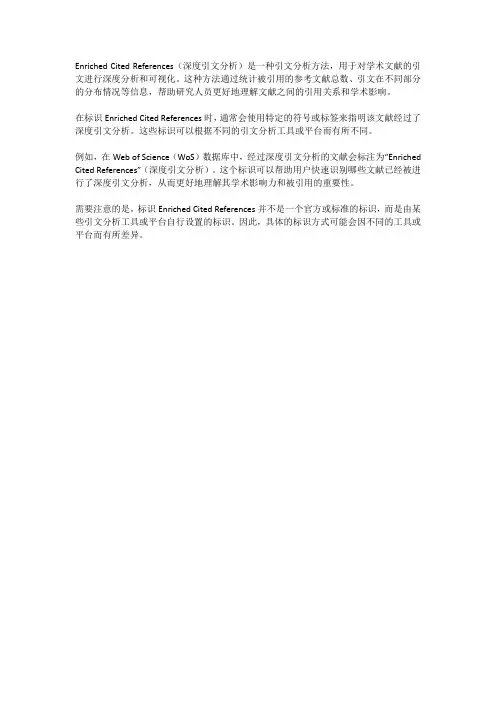
Enriched Cited References(深度引文分析)是一种引文分析方法,用于对学术文献的引文进行深度分析和可视化。
这种方法通过统计被引用的参考文献总数、引文在不同部分的分布情况等信息,帮助研究人员更好地理解文献之间的引用关系和学术影响。
在标识Enriched Cited References时,通常会使用特定的符号或标签来指明该文献经过了深度引文分析。
这些标识可以根据不同的引文分析工具或平台而有所不同。
例如,在Web of Science(WoS)数据库中,经过深度引文分析的文献会标注为“Enriched Cited References”(深度引文分析)。
这个标识可以帮助用户快速识别哪些文献已经被进行了深度引文分析,从而更好地理解其学术影响力和被引用的重要性。
需要注意的是,标识Enriched Cited References并不是一个官方或标准的标识,而是由某些引文分析工具或平台自行设置的标识。
因此,具体的标识方式可能会因不同的工具或平台而有所差异。
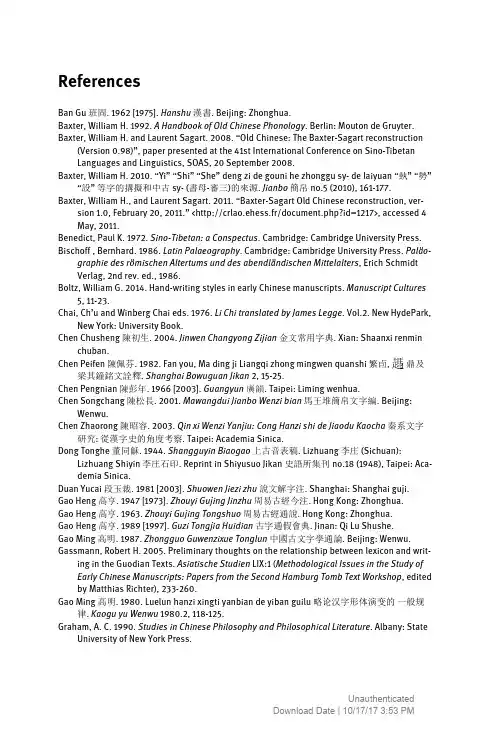
ReferencesBan Gu 班固. 1962 [1975]. Hanshu漢書. Beijing: Zhonghua.Baxter, William H. 1992. A Handbook of Old Chinese Phonology. Berlin: Mouton de Gruyter. Baxter, William H. and Laurent Sagart. 2008. “Old Chinese: The Baxter-Sagart reconstruction (Version 0.98)”, paper presented at the 41st International Conference on Sino-Tibetan Languages and Linguistics, SOAS, 20 September 2008.Baxter, William H. 2010. “Yi” “Shi” “She” deng zi de gouni he zhonggu sy- de laiyuan “埶” “勢”“設” 等字的搆擬和中古sy- (書母-審三)的來源. Jianbo簡帛no.5 (2010), 161-177. Baxter, William H., and Laurent Sagart. 2011. “Baxter-Sagart Old Chinese reconstruction, ver-sion 1.0, February 20, 2011.” <http://crlao.ehess.fr/document.php?id=1217>, accessed 4 May, 2011.Benedict, Paul K. 1972. Sino-Tibetan: a Conspectus. Cambridge: Cambridge University Press. Bischoff , Bernhard. 1986. Latin Palaeography. Cambridge: Cambridge University Press. Paläo-graphie des römischen Altertums und des abendländischen Mittelalters, Erich Schmidt Verlag, 2nd rev. ed., 1986.Boltz, William G. 2014. Hand-writing styles in early Chinese manuscripts. Manuscript Cultures 5, 11-23.Chai, Ch’u and Winberg Chai eds. 1976. Li Chi translated by James Legge. Vol.2. New HydePark, New York: University Book.Chen Chusheng 陳初生. 2004. Jinwen Changyong Zijian金文常用字典. Xian: Shaanxi renmin chuban.鼎及Chen Peifen 陳佩芬. 1982. Fan you, Ma ding ji Liangqi zhong mingwen quanshi 繁卣, 梁其鐘銘文詮釋. Shanghai Bowuguan Jikan 2, 15-25.Chen Pengnian 陳彭年. 1966 [2003]. Guangyun廣韻. Taipei: Liming wenhua.Chen Songchang 陳松長. 2001. Mawangdui Jianbo Wenzi bian馬王堆簡帛文字編. Beijing: Wenwu.Chen Zhaorong 陳昭容. 2003. Qin xi Wenzi Yanjiu: Cong Hanzi shi de Jiaodu Kaocha秦系文字研究: 從漢字史的角度考察. Taipei: Academia Sinica.Dong Tonghe 董同龢. 1944. Shangguyin Biaogao上古音表稿. Lizhuang 李庄 (Sichuan): Lizhuang Shiyin 李庄石印. Reprint in Shiyusuo Jikan 史語所集刊no.18 (1948), Taipei: Aca-demia Sinica.Duan Yucai 段玉裁. 1981 [2003]. Shuowen Jiezi zhu說文解字注. Shanghai: Shanghai guji.Gao Heng 高亨. 1947 [1973]. Zhouyi Gujing Jinzhu周易古經今注. Hong Kong: Zhonghua.Gao Heng 高亨. 1963. Zhouyi Gujing Tongshuo周易古經通說. Hong Kong: Zhonghua.Gao Heng 高亨. 1989 [1997]. Guzi Tongjia Huidian古字通假會典. Jinan: Qi Lu Shushe.Gao Ming 高明. 1987. Zhongguo Guwenzixue Tonglun中國古文字學通論. Beijing: Wenwu. Gassmann, Robert H. 2005. Preliminary thoughts on the relationship between lexicon and writ-ing in the Guodian Texts. Asiatische Studien LIX:1 (Methodological Issues in the Study of Early Chinese Manuscripts: Papers from the Second Hamburg Tomb Text Workshop, edited by Matthias Richter), 233-260.Gao Ming 高明. 1980. Luelun hanzi xingti yanbian de yiban guilu 略论汉字形体演变的一般规律. Kaogu yu Wenwu 1980.2, 118-125.Graham, A. C. 1990. Studies in Chinese Philosophy and Philosophical Literature. Albany: State University of New York Press.324 | ReferencesGuo Moruo 郭沫若. 1935. Liang Zhou Jinwen ci Daxi Kaoshi 兩周金文辭大系攷釋. Tokyo: Bunkyudo.Handel, Zev. 2012. Valence-Changing Prefixes and Voicing Alternation in Old Chinese and Proto-Sino-Tibetan: Reconstructing *s- and *N- Prefixes. Language and Linguistics 13.1, 61-82.Han Ziqiang 韓自強. 2004. Fuyang Han jian Zhouyi Yanjiu阜陽漢簡周易研究. Shanghai: Shanghai guji.He Linyi 何琳仪. 1998 [2004]. Zhanguo Guwen Zidian; Zhanguo Wenzi Shengxi戰國古文字典-戰國文字聲系. Beijing: Zhonghua.He Linyi 何琳仪. 2003. Zhanguo Wenzi Tonglun Dingbu战国文字通论订补. Nanking: Jiangsu jiaoyu.He Linyi何琳仪, Cheng Yan 程燕and Fang Zhensan 房振三. 2006. Hujian Zhouyi xuanshi (xiuding) 沪简周易选释(修订). Zhouyi Yanjiu 75 (2006, no.1), 3-6.Huang Xiquan 黃錫全. 1990. Chu xi wenzi lüe lun 楚系文字略論. Huaxia Kaogu 1990.3, 99-108. Jacques, Guillaume. 2012. An internal reconstruction of Tibetan stem alternations. Transac-tions of the Philological Society Volume 110:2 (2012), 212-224.Jiang Liangfu 姜亮夫. 1999. Guwenzi xue古文字學. Kunming: Yunnan renmin.Karlgren, Bernhard. 1954. Compendium of Phonetics in Ancient and Archaic Chinese. Bulletin of the Museum of Far Eastern Antiquities 26, 211-367.Karlgren, Bernhard. 1956. Cognate words in the Chinese phonetic series. Bulletin of the Mu-seum of Far Eastern Antiquities 28, 1-18.Karlgren, Bernhard. 1957. Grammata Serica Recensa. Stockholm: Museum of Far Eastern Antiq-uities. Reprinted from Bulletin of the Museum of Far Eastern Antiquities 29.Lai Guolong 來國龍. 2014. Shi zhen yu zhen jian shuo Chu jian “丨”zide guyun guibu ji guwenzi tongyii ziru de yizhong teshu gouxing fangshi 釋謹與慎—兼說楚簡“丨”字的古韻歸部及古文字同義字孳乳的一種特殊構形方式 . Wuhan Daxue Jianbo Yanjiu Zhongxin武漢大學簡帛研究中心 </show_article.php?id=2003> , accessed 17 June, 2014 Legge, James. n.d., preface dated 1872. The Chinese Classics with a translation, critical and ex-egetical notes, prolegomena, and copious indexes, Vol. V.-Part I. Hong Kong: London mis-sionary’s Printing office.Li Fang-kuei (F.K. Li) 李方桂. 1971 [1982]. Shangguyin Yanjiu上古音研究. Beijing: Shangwu.Li Ling 李零. 2006. Du Shangbo Chu jian Zhouyi 读上博楚简周易. Zhonguo Lishi Wenwu 2006.4, 54-67.Li Ling 李零. 2008. Shiri, rishu he yeshu-san zhong jianbo wenxian de qubie he dingming 視日,日書和葉書三種簡帛文献的區别和定名. Wenwu 2008.12, 73-80.Li Rong 李荣. 1965. Cong xiandai fangyan lun gu qunmu you yi, er, si deng 从现代方言论古群母有一,二,四等. Zhonguo yuwen 1965.5, 337-342, 355.Li Shoukui 李守奎. 2003. Chu Wenzi bian楚文字編. Shanghai: Huadong Shifan daxue.Li Xinkui 李新魁. 1982 [2006]. Yunjing Jiaozheng韻鏡校證. Beijing: Zhonghua.Li Xueqin李學勤. 1959. Zhanguo timing gaishu (shang), (zhong), (xia) 战国题铭概述 (上), (中), (下). Wenwu 1959.7, 50-54 (上), Wenwu 1959. 8, 60-63 (中), Wenwu 1959. 9, 58-61 (下).Li Xueqin 李學勤 et al. ed. 2000. Shisanjing Zhushu十三經注疏 . Beijing: Beijing Daxue chu-ban.Li Yu 李玉. 1994. Qin Han Jiandu Boshu Yinyun Yanjiu秦漢簡牘帛書音韻研究. Beijing: Dangdai zhongguo.325| ReferencesLi Yunfu 李運富. 1997. Cong wenzi de gouxing xitong kan zhanguo wenzi zai hanzi fazhanshishang de diwei 从文字的构形系统看战国文字在汉字发展史上的地位. Xuzhou ShifanDaxue Xuebao 1997.3, 35-39.Liao Mingchun 廖明春. 2001. Zhouyi Jingzhuan yu Yixue shi Xinlun周易经传与易学新论. Jinan:Qi Lu shushe.Liu Baojun 刘宝俊. 1986. Qin Han boshu yinxi gaishu 秦汉帛书音系概述. Zhongnan MinzuXueyuan Xuebao 1986.1, 126-131.Liu Xiang劉翔. 1986. Fu qi lüe shuo 簠器略說. Guwenzi Yanjiu 13, 458-463.Lu Deming 陸德明. 1985. Jingdian Shiwen經典釋文 (3 vols). Shanghai: Shanghai guji.Lü Dalin 呂大臨. 1991. Kao gu tu考古圖 (10 juan). Huang Xiaofeng 黃曉峰 edition (1753), photo-copy reprint by Jiangsu, Guangling 廣陵 guji.Ma Chengyuan 馬承源 ed. 1987-1990. Shang Zhou Qingtongqi Mingwen xuan商周青銅器銘文選. Beijing: Wenwu.Ma Chengyuan 馬承源, ed. 2001-2012. Shanghai Bowuguan cang Zhanguo Chu zhushu上海博物館藏戰國楚竹書vols. 1-9. Shanghai: Shanghai guji.Ma Chengyuan馬承源ed. 2003. Shanghai Bowugan cang Zhanguo Chu zhushu (San) 上海博物館藏戰國楚竹書 (三). Shanghai: Shanghai guji.Ma Xulun 馬叙倫. 1970. Shuowen Jiezi Yanjiu說文解字研究. Hong Kong: Taiping.Matisoff, James A. 2003. Handbook of Proto-Tibeto-Burman: System and Philosophy of Sino-Tibetan reconstruction. Berkeley and Los Angeles: University of California Press.Matisoff, James A. 2006. “Deltacism of laterals in Sino-Tibetan and elsewhere”,</pdf/JAM/DinguistDilemma-2006.pdf>, accessed on May 8,2014; a revised version of “Dinguist’s Dilemma: deltacism of laterals in Sino-Tibetan”, apaper presented at the 23rd International Conference on Sino-Tibetan Languages and Lin-guistics, University of Texas at Arlington, Oct., 3-6, 1990.Mei Tsu-lin 梅祖麟. 1979. Sino-Tibetan “year”, “month”, “foot” and “vulva”. Ch’inghuaHsuehpao new series 12.1-2, 117-134.Mei, Tsu-lin. 2012. The causative *s- and nominalizing *-s in Old Chinese and related matters inProto-Sino-Tibetan. Language and Linguistics 13.1, 1-28.Norman, Jerry. 1994. Pharyngealization in Early Chinese, Journal of the American Oriental Soci-ety 114.3, 397-408.Pan Wuyun 潘悟云. 1997. Houyinkao 喉音考. Minzu Yuwen 1997.5, 10-24.Park, Haeree. 2008. A revision of the chuan 川 phonetic series through discovered texts. Chi-nese Linguistics in Leipzig. Paris: Centre de Recherches Linguistiques sur l’Asie Orientale,39-51.Park, Haeree. 2009. The Shanghai Museum Zhouyi Manuscript and the Warring States WritingSystem. Ph.D. dissertation. University of Washington, Seattle.Park, Haeree. 2011. Shuping 书评: Zhanguo Chu fangyan yinxi 战国楚方言音系 (Review articleof Zhao Tong’s Chu Fangyan Yinxi, 2006). Yuyanxue Luncong 44, (Peking Univeristy), 356-381.Pu Maozuo 濮茅左. 2003. Transcription and annotation of the “Zhouyi 周易” in ShanghaiBowugan cang Zhanguo Chu zhushu (san)上海博物館藏戰國楚竹書 (三) edited by MaChengyuan馬承源, 131-260. Shanghai: Shanghai guji.Pulleyblank, Edwin G. 1962. The Consonantal system of Old Chinese, Part I, Asia Major New se-ries 9, 58-144.326 | ReferencesPulleyblank, Edwin G. 1978. Emphatic negatives in classical Chinese. Ancient China: Studies in Early Civilization edited by David T. Roy and Tsuen-hsuin Tsien, 115-136. Hong Kong: Chi-nese Univiversity Press.Qiu Xigui 裘锡圭. 1988 [2002]. Wenzixue Gaiyao文字学概要. Beijing: Shangwu.Qiu Xigui裘锡圭. 1992. Guwenzi Lunji古文字論集. Beijing: Zhonghua.Qiu Xigui 裘锡圭. 1998. Jiaguwen zhong de jian yu shi 甲骨文中的見與視. Jiaguwen faxian yibai zhounian xueshu yantaohui lunwenji甲骨文發現一百周年學術研討會論文集edited by Taiwan Shifan Daxue guowenxue xi and Academia Sinica, Institute of History and linguis-tics, 1-7. Taipei.Richter, Matthias. 2005. Towards a profile of graphic variation: on the distribution of graphic variants within the Mawangdui Laozi manuscript. Methodological Issues in the Study of Early Chinese Manuscripts: Papers from the Second Hamburg Tomb text Workshop, Mat-thias Richter ed., AsiatischeStudien/ Etudes Asiatiques LIX∙1∙2005. Bern: Peter Lang. Richter, Matthias, 2006. Tentative criteria for discerning individual hands in the Guodian Manuscripts. Manuscript. 28 pages. Published in: Rethinking Confucianism: Selected Pa-pers from the Third International Conference on Excavated Chinese Manuscripts, Mount Holyoke College, April 2004, edited by Xing Wen, San Antonio: Trinity University, 132-147. Richter, Matthias. forthcoming. Punctuation. Manuscript. 80 pages. To appear in Reading Early Chinese Manuscripts: Texts, Contexts, Methods, edited by Wolfgang Behr, MartinKern and Dirk Meyer. Leiden: Brill.Rong Geng 容庚. 1985 [2005]. Jinwen bian金文編. Beijing: Zhonghua.Ruan Yuan 阮元. 1980 [2003]. Shisan jing Zhushu十三經注疏. Beijing: Zhonghua.Sagart, Laurent. 2003. Sources of Middle Chinese manner types: Old Chinese pre-nasalized initials in Hmong-Mien and Sino-Tibetan perspective. Language and Linguistics 4.4, 757-768.Sagart, Laurent. 2006. On intransitive nasal prefixation in Sino-Tibetan languages. Cahiers de Linguistique – Asie Orientale 35.1, 57-70.Sagart, Laurent. 2007. “Reconstructing Old Chinese uvulars in the Baxter-Sagart system”, pa-per presented at the 40th ICSTLL, Harbin, September 27-29, 2007.Sagart, Laurent, and William H. Baxter. 2009. Reconstructing Old Chinese uvulars in the Bax-ter-Sagart system (Version 0.99). Cahiers de Linguistique – Asie Orientale 38.2, 221-244. Sagart, Laurent, and William H. Baxter. 2012. Reconstructing the *s- prefix in Old Chinese. Lan-guage and Linguistics 13.1, 29-59.Schuessler, Axel. 1974. R and L in Archaic Chinese. Journal of Chinese Linguistics 2, 186-199. Shadong sheng wenwu gongzuo weiyuanhui 山东省文物工作委员会. 1976. Houma Mengshu 侯马盟书. Shanghai: Wenwu.Shao Rongfen 邵榮芬. 1991. Xiamuzi shanggu yi fen wei er shixi 匣母上古一分爲二试析. Yuyan Yanjiu 20.1, 118-127.Shaughnessy, Edward L. 1993. I Ching 易經 (Chou I 周易). Early Chinese texts: A Bibliographical Guide edited by Michael Loewe, 216-228. Berkeley: The Society for the study of EarlyChina and the institute of East Asian studies, University of California, Berkeley. Shaughnessy, Edward L. 2006. Α first Reading of the Shanghai Museum Bamboo-Strip Manu-script of the Zhouyi, Early China 30 (2005-2006), 1-24.Shaughnessy, Edward L. 2014. Unearthing the “Changes”: Recently Discovered Manuscripts of the Yi Jing (I Ching) and Related Texts. New York: Columbia University Press.Sima Qian 司馬遷. 1959 [1962]. Shiji史記. Beijing: Zhonghua.327| ReferencesStarostin, Sergei Anatolyevich. 1989 [2010]. Gudai Hanyu Yinxi de gouni古代漢語音系的構擬(Chinese translation of Rekonstruckcija drevnekitajskoj fonologic̆e skoj sistemy. Moscow:Nauka, Glavnaja Redakcija vostoc̆n oj Literatury, 1989). Shanghai: Shanghai jiaoyu chuban上海敎育出版.Sun Shuxia 孫淑霞. 2013. Chutu Cang Jie pian gaishu 出土蒼頡篇概述. Wuhan Daxue JianboYanjiu Zhongxin 武漢大學簡帛研究中心 </show_arti-cle.php?id=1948>, accessed 6 June, 2014.Tang Lan 唐蘭. 1965. Guwenzixue Daolun古文字學導論 (2 vols). Hong Kong: Taiping.Tang Yuhui 湯余惠. 1986. Lüelun Zhanguo wenzi xingti yanjiu zhong de jige wenti 略論戰國文字形體研究中的幾個問題. Guwenzi Yanjiu 15, 9-101.Teng Rensheng 滕壬生. 2008. Chu xi Jianbo Wenzi bian, Zengding ben楚系簡帛文字編: 增訂本Wuhan: Hubeijiaoyu 湖北教育出版社.Ting Pang-hsin. 1977. Archaic Chinese *g, *gw, *γ and *γw. Monumeta Serica 33 (1977-1978),171-179.Wang Chong 王充. 1974. Lunheng論衡. Shanghai: Shanghai renmin.Wang Guowei 王國維. 1976. Shi Zhou pian Xulu史籀篇叙錄. Taipei: Taiwan Shangwu.Wang Li 王力. 2000. Wang Li Guhanyu Zidian王力古漢語字典. Beijing: Zhonghua.Watson, William. 1961. China before the Han Dynasty. New York: Frederick A. Praeger.Wu Zhenfeng 吳鎭烽. 2006. Jinwen Renming Huibian金文人名彙編. Beijing: Zhonghua.Xiao Congli 肖從禮. 2011. Qin Han jiandu “zhiri” kao 秦漢簡牘“質日”考. Fudan Daxue Guwen-xian yu Guwenzi Yanjiu Zhongxin 复旦大学古文献与古文字研究中心,</SrcShow.asp?Src_ID=1427>, accessed 4 June, 2014.Xin Ting 新亭. 2014. Qishan Zhougong miao bu jia “Wang Si Mei Ke ben yi yu miao” de guanchahe sikao 岐山周公廟卜甲“王斯妹克奔逸于廟”的觀察和思考. Fudan Daxue chutu wenxianyu guwenzi yanjiu zhongxin 复旦大学出土文献与古文字研究中心. <http://www.gwz.fu-/SrcShow.asp?Src_ID=2254>, accessed 17 June, 2014Xu Dan 徐丹. 2004. Shanggu hanyu houqi foudingci ‘wu’ daiti ‘wang’ 上古漢語後期否定詞無代替亡. Hanyu shi Xuebao 5, 64-72.Xu Xiongzhi 許雄志. 2001. Qin yin Wenzi Huibian秦印文字彙編. Zhengzhou: Henan meishu.Xu Zhongshu 徐中舒. 1981. Hanyu Guwenzi Zixing biao漢語古文字字形表. Sichuan, HongKong: Sichuan renmin, Zhonghua.Yakhontov, S. E. 1976 [1986]. Shanggu Hanyude kaitou fuyin L he R 上古汉语的开头辅音L和 Rin Hanyushi Lunji汉语史论集 edited by Tang Zuofan 唐作藩and Hu Shuangbao 胡双宝,156-165. Beijing: Beijing Daxue.Yakhontov, S. E. 1960 [1986]. Shanggu hanyude chunhua yuanyin 上古汉语的唇化元音Hanyu-shi Lunji edited by Tang Zuofan and Hu Shuangbao, 42-51. Beijing: Beijing Daxue.Zeng Xiantong 曾憲通. 1982. Santi shijing guwen yu Shuowen guwen hezheng 三體石經古文與說文古文合證. Guwenzi Yanjiu 7, 273-87.Zeng Xiantong 曾憲通. 2005. Guwenzi yu Chutu Wenxian Congkao 古文字与出土文献丛考.Guangzhou: Zhongshan daxue.Zhang Ru 张儒. 1988. Guanyu zhushu, boshu tongjiazi de kaocha 关于竹书帛书通假字的考察.Shanxi Daxue Xuebao 1988.2, 37-43.Zhang Shouzhong 張守中. 1981. Zhongshan Wang Cuo qi Wenzi bian中山王器文字編. Bei-jing: honghua.Zhang Shouzhong 張守中. 1994. Shuihudi Qin jian Wenzi bian睡虎地秦簡文字編. Beijing:Wenwu.328 | ReferencesZhang Zhenlin 張振林. 1982. Xian Qin guwenzi cailiao zhong de yuqici 先秦古文字材料中的語氣詞. Guwenzi Yanjiu 7, 289-307.Zhang Zhenglang张政烺. 1984. Mawangdui Liu shi si Gua ba 马王堆六十四卦拔. Wenwu 1984.3, 9-14.Zhao Chao 趙超. 2006. Shike Guwenzi石刻古文字. Beijing: Wenwu.Zhao Cheng 赵诚. 1986. Linyi Hanjiande tongjiazi 临沂汉简的通假字. Yinyunxue Yanjiu (er)音韵學研究edited by Zhongguo yinyunxue yanjiuhui, 17-26. Beijing: Zhonghua.Zhao Liwei 趙立偉. 2002. Shuihudi Qin mu zhujian tongjiazi yanjiu 睡虎地秦墓竹簡通假字研究. Jianbo Yuyan Wenzi Yanjiu di yi ji簡帛語言文字研究第一輯 edited by Zhang Xian-cheng 張顯成, 326-73. Chengdu: Bashu.Zhao Tong 赵彤. 2006. Zhanguo Chu Fangyan Yinxi战国楚方言音系. Beijing: Zhonguo xiju chu-banshe.Zhongguo shehui kexueyuan kaogu yanjiusuo 中國社會科學院考古研究所.1984-1994. Yin Zhou Jinwen Jicheng 殷周金文集成. Beijing: Shangwu.Zhongguo kexueyuan kaogu yanjiusuo 中國科學院考古研究所. 1965. Jiagu wen bian甲骨文編.Beijing: Zhonghua.Zhouyuan kaogu dui 周原考古隊. 2006. 2003 nian Shanxi Qishan Zhougong miao yizhi diao-cha baogao 2003年陝西岐山周公廟遺址調查報告. Gudai Wenming古代文明, vol. 5(2006), 151-186, Beijing: Wenwu.Zhou Zumo 周祖謨. 1983. Tang Wudai Yunshu Jicun唐五代韻書集存. 2 vols. Beijing: Zhong-hua.Zhou Zumo 周祖謨. 1984. Handai Zhushu yu boshu zhong de tongjiazi yu guyinde kaoding 汉代竹书与帛书中的通假字与古音的考订in Yinyunxue Yanjiu (yi) 音韵學研究(一), edited by Zhongguo yinyunxue yanjiuhui, 78-91. Beijing: Zhonghua.Zhou Zumo 周祖謨. 1993 [2004]. Fangyan Jiaojian 方言校箋. Beijing: Zhonghua.。
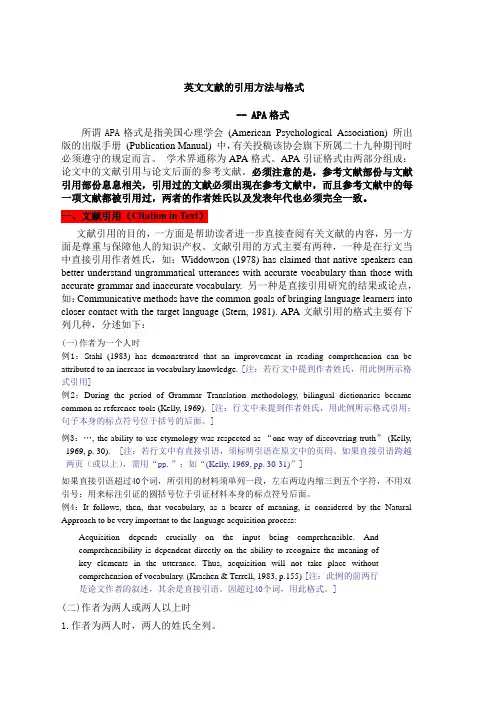
英文文献的引用方法与格式-- APA格式所谓APA格式是指美国心理学会(American Psychological Association) 所出版的出版手册(Publication Manual)中,有关投稿该协会旗下所属二十九种期刊时必须遵守的规定而言。
学术界通称为APA格式。
APA引证格式由两部分组成:论文中的文献引用与论文后面的参考文献。
必须注意的是,参考文献部份与文献引用部份息息相关,引用过的文献必须出现在参考文献中,而且参考文献中的每一项文献都被引用过,两者的作者姓氏以及发表年代也必须完全一致。
一、文献引用(Citation in Text)文献引用的目的,一方面是帮助读者进一步直接查阅有关文献的内容,另一方面是尊重与保障他人的知识产权。
文献引用的方式主要有两种,一种是在行文当中直接引用作者姓氏,如:Widdowson (1978) has claimed that native speakers can better understand ungrammatical utterances with accurate vocabulary than those with accurate grammar and inaccurate vocabulary.另一种是直接引用研究的结果或论点,如:Communicative methods have the common goals of bringing language learners into closer contact with the target language (Stern, 1981). APA文献引用的格式主要有下列几种,分述如下:(一)作者为一个人时例1:Stahl (1983) has demonstrated that an improvement in reading comprehension can be attributed to an increase in vocabulary knowledge.[注:若行文中提到作者姓氏,用此例所示格式引用]例2:During the period of Grammar Translation methodology, bilingual dictionaries became common as reference tools (Kelly, 1969). [注:行文中未提到作者姓氏,用此例所示格式引用;句子本身的标点符号位于括号的后面。
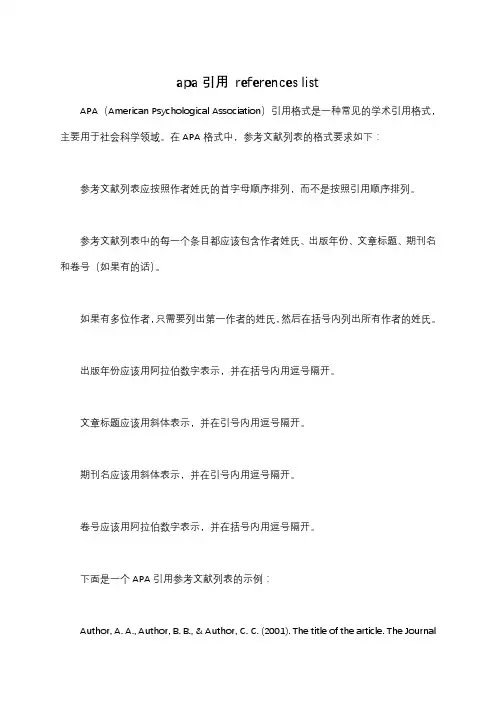
apa引用references list
APA(American Psychological Association)引用格式是一种常见的学术引用格式,主要用于社会科学领域。
在APA格式中,参考文献列表的格式要求如下:
参考文献列表应按照作者姓氏的首字母顺序排列,而不是按照引用顺序排列。
参考文献列表中的每一个条目都应该包含作者姓氏、出版年份、文章标题、期刊名和卷号(如果有的话)。
如果有多位作者,只需要列出第一作者的姓氏,然后在括号内列出所有作者的姓氏。
出版年份应该用阿拉伯数字表示,并在括号内用逗号隔开。
文章标题应该用斜体表示,并在引号内用逗号隔开。
期刊名应该用斜体表示,并在引号内用逗号隔开。
卷号应该用阿拉伯数字表示,并在括号内用逗号隔开。
下面是一个APA引用参考文献列表的示例:
Author, A. A., Author, B. B., & Author, C. C. (2001). The title of the article. The Journal
of Relevant Studies, 12(3), 1-20.
在这个示例中,参考文献列表包含一个条目,即一个期刊文章。
条目包含了作者姓氏、出版年份、文章标题、期刊名和卷号。
注意,APA格式要求在括号内使用逗号来分隔不同的信息。
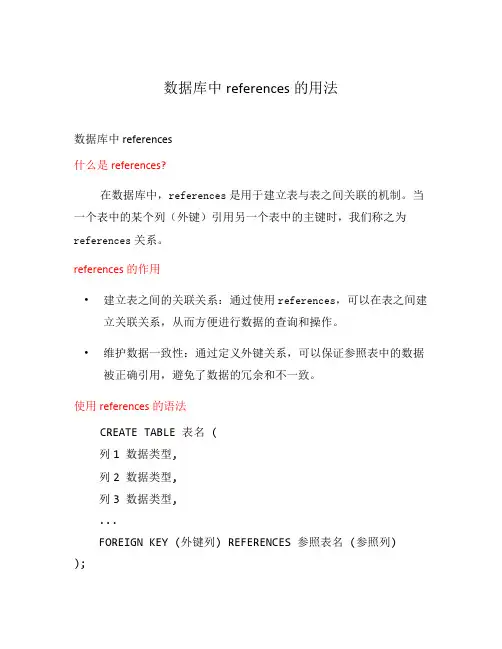
数据库中references的用法数据库中references什么是references?在数据库中,references是用于建立表与表之间关联的机制。
当一个表中的某个列(外键)引用另一个表中的主键时,我们称之为references关系。
references的作用•建立表之间的关联关系:通过使用references,可以在表之间建立关联关系,从而方便进行数据的查询和操作。
•维护数据一致性:通过定义外键关系,可以保证参照表中的数据被正确引用,避免了数据的冗余和不一致。
使用references的语法CREATE TABLE 表名 (列1 数据类型,列2 数据类型,列3 数据类型,...FOREIGN KEY (外键列) REFERENCES 参照表名 (参照列));其中,外键列对应当前表中需要引用另一个表的列,参照表名是被引用的表的名称,参照列是被引用的表中的主键列。
references的用法1.一对一关系:当两个表之间存在一对一的关系时,可以使用references来建立关联。
例如,有一个表存储员工信息,另一个表存储员工的办公室信息。
可以通过在员工表中建立外键引用办公室表的主键,来表示每个员工只能拥有一个办公室。
2.一对多关系:当一个表中的某个列需要引用另一个表中的多个行时,可以使用references来建立关联。
例如,在一个学生表中,每个学生可以有多个课程。
可以在学生表中建立外键引用课程表的主键,来表示每个学生可以参加多门课程。
3.多对多关系:当两个表之间存在多对多的关系时,需要通过中间表来建立关联。
例如,有一个商品表和一个订单表,一个商品可以出现在多个订单中,一个订单中可以包含多个商品。
可以通过在中间表中建立外键分别引用商品表和订单表的主键,来表示商品和订单之间的关系。
4.级联操作:通过定义外键的级联操作,可以自动更新或删除关联表中的数据。
例如,当删除一个课程时,可以通过设置外键的级联操作将学生表中关于该课程的记录一并删除。
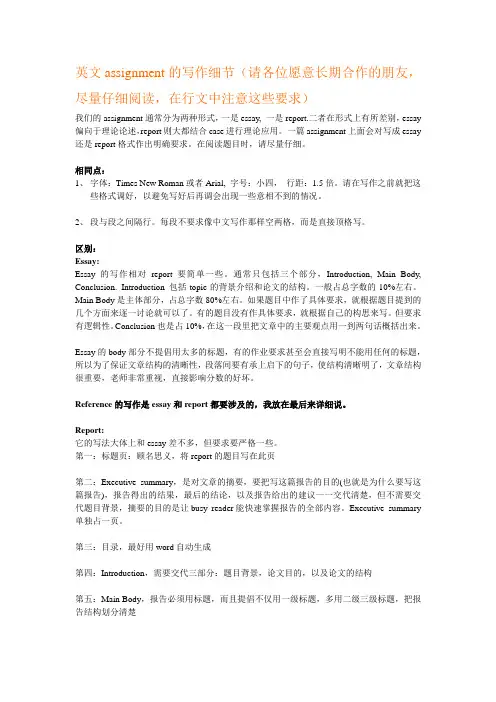
英文assignment的写作细节(请各位愿意长期合作的朋友,尽量仔细阅读,在行文中注意这些要求)我们的assignment通常分为两种形式,一是essay, 一是report.二者在形式上有所差别,essay 偏向于理论论述,report则大都结合case进行理论应用。
一篇assignment上面会对写成essay 还是report格式作出明确要求。
在阅读题目时,请尽量仔细。
相同点:1、字体:Times New Roman或者Arial, 字号:小四,行距:1.5倍。
请在写作之前就把这些格式调好,以避免写好后再调会出现一些意相不到的情况。
2、段与段之间隔行。
每段不要求像中文写作那样空两格,而是直接顶格写。
区别:Essay:Essay的写作相对report要简单一些。
通常只包括三个部分,Introduction, Main Body, Conclusion. Introduction 包括topic的背景介绍和论文的结构。
一般占总字数的10%左右。
Main Body是主体部分,占总字数80%左右。
如果题目中作了具体要求,就根据题目提到的几个方面来逐一讨论就可以了。
有的题目没有作具体要求,就根据自己的构思来写。
但要求有逻辑性。
Conclusion也是占10%,在这一段里把文章中的主要观点用一到两句话概括出来。
Essay的body部分不提倡用太多的标题,有的作业要求甚至会直接写明不能用任何的标题,所以为了保证文章结构的清晰性,段落间要有承上启下的句子,使结构清晰明了,文章结构很重要,老师非常重视,直接影响分数的好坏。
Reference的写作是essay和report都要涉及的,我放在最后来详细说。
Report:它的写法大体上和essay差不多,但要求要严格一些。
第一:标题页:顾名思义,将report的题目写在此页第二:Executive summary,是对文章的摘要,要把写这篇报告的目的(也就是为什么要写这篇报告),报告得出的结果,最后的结论,以及报告给出的建议一一交代清楚,但不需要交代题目背景,摘要的目的是让busy reader能快速掌握报告的全部内容。
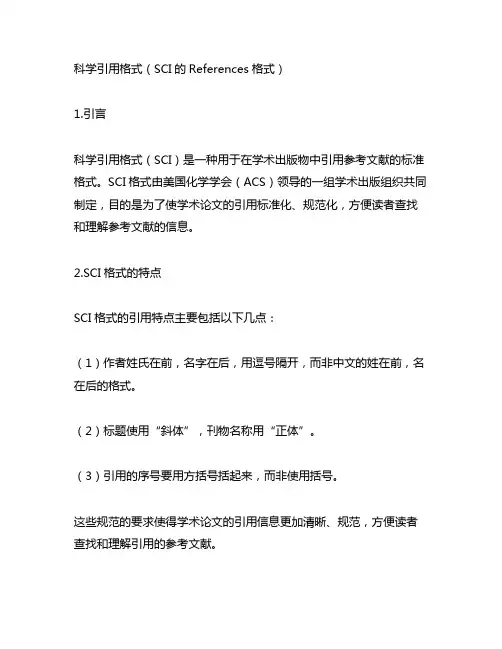
科学引用格式(SCI的References格式)1.引言科学引用格式(SCI)是一种用于在学术出版物中引用参考文献的标准格式。
SCI格式由美国化学学会(ACS)领导的一组学术出版组织共同制定,目的是为了使学术论文的引用标准化、规范化,方便读者查找和理解参考文献的信息。
2.SCI格式的特点SCI格式的引用特点主要包括以下几点:(1)作者姓氏在前,名字在后,用逗号隔开,而非中文的姓在前,名在后的格式。
(2)标题使用“斜体”,刊物名称用“正体”。
(3)引用的序号要用方括号括起来,而非使用括号。
这些规范的要求使得学术论文的引用信息更加清晰、规范,方便读者查找和理解引用的参考文献。
3.SCI格式的应用范围SCI格式广泛应用于自然科学和工程技术领域的学术出版物中,如物理学、化学、生物学、材料科学等领域。
SCI格式的引用标准被认为是国际上学术界最权威的引用标准之一,因此在相关领域的学术出版物中广泛使用。
4.SCI格式的引用要求SCI格式的引用要求非常严格,引用时需要按照一定的格式和顺序来列出参考文献的信息。
一般来说,SCI格式的引用要求包括以下内容:(1)作者的尊称(姓氏在前,名字在后)。
(2)文献的标题(使用斜体)。
(3)刊物的名称(使用正体)。
(4)刊物的卷号、期号和页码。
(5)出版年份。
5.SCI格式的示例以下是一篇使用SCI格式引用的参考文献示例:[1] Smith, J. A. The effects of climate change on marine ecosystems. Nature, 2015, 523(7561): 418-420.上面的引用示例中,方括号内的数字1表示引用的序号,Smith, J. A.是作者的尊称,The effects of climate change on marine ecosystems是文献的标题,Nature是刊物的名称,2015是出版年份,523是卷号,7561是期号,418-420是页码。
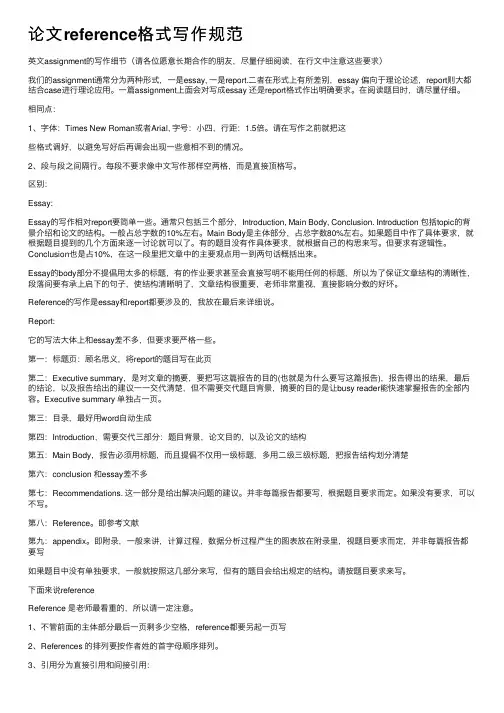
论⽂reference格式写作规范英⽂assignment的写作细节(请各位愿意长期合作的朋友,尽量仔细阅读,在⾏⽂中注意这些要求)我们的assignment通常分为两种形式,⼀是essay, ⼀是report.⼆者在形式上有所差别,essay 偏向于理论论述,report则⼤都结合case进⾏理论应⽤。
⼀篇assignment上⾯会对写成essay 还是report格式作出明确要求。
在阅读题⽬时,请尽量仔细。
相同点:1、字体:Times New Roman或者Arial, 字号:⼩四,⾏距:1.5倍。
请在写作之前就把这些格式调好,以避免写好后再调会出现⼀些意相不到的情况。
2、段与段之间隔⾏。
每段不要求像中⽂写作那样空两格,⽽是直接顶格写。
区别:Essay:Essay的写作相对report要简单⼀些。
通常只包括三个部分,Introduction, Main Body, Conclusion. Introduction 包括topic的背景介绍和论⽂的结构。
⼀般占总字数的10%左右。
Main Body是主体部分,占总字数80%左右。
如果题⽬中作了具体要求,就根据题⽬提到的⼏个⽅⾯来逐⼀讨论就可以了。
有的题⽬没有作具体要求,就根据⾃⼰的构思来写。
但要求有逻辑性。
Conclusion也是占10%,在这⼀段⾥把⽂章中的主要观点⽤⼀到两句话概括出来。
Essay的body部分不提倡⽤太多的标题,有的作业要求甚⾄会直接写明不能⽤任何的标题,所以为了保证⽂章结构的清晰性,段落间要有承上启下的句⼦,使结构清晰明了,⽂章结构很重要,⽼师⾮常重视,直接影响分数的好坏。
Reference的写作是essay和report都要涉及的,我放在最后来详细说。
Report:它的写法⼤体上和essay差不多,但要求要严格⼀些。
第⼀:标题页:顾名思义,将report的题⽬写在此页第⼆:Executive summary,是对⽂章的摘要,要把写这篇报告的⽬的(也就是为什么要写这篇报告),报告得出的结果,最后的结论,以及报告给出的建议⼀⼀交代清楚,但不需要交代题⽬背景,摘要的⽬的是让busy reader能快速掌握报告的全部内容。
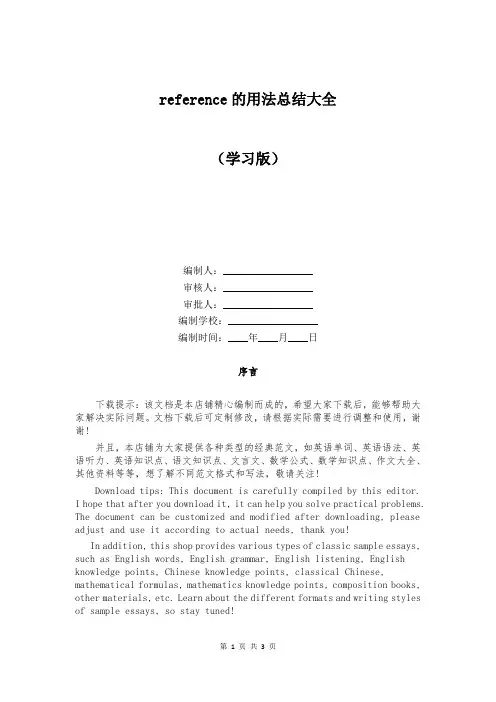
reference的用法总结大全(学习版)编制人:__________________审核人:__________________审批人:__________________编制学校:__________________编制时间:____年____月____日序言下载提示:该文档是本店铺精心编制而成的,希望大家下载后,能够帮助大家解决实际问题。
文档下载后可定制修改,请根据实际需要进行调整和使用,谢谢!并且,本店铺为大家提供各种类型的经典范文,如英语单词、英语语法、英语听力、英语知识点、语文知识点、文言文、数学公式、数学知识点、作文大全、其他资料等等,想了解不同范文格式和写法,敬请关注!Download tips: This document is carefully compiled by this editor.I hope that after you download it, it can help you solve practical problems. The document can be customized and modified after downloading, please adjust and use it according to actual needs, thank you!In addition, this shop provides various types of classic sample essays, such as English words, English grammar, English listening, English knowledge points, Chinese knowledge points, classical Chinese, mathematical formulas, mathematics knowledge points, composition books, other materials, etc. Learn about the different formats and writing styles of sample essays, so stay tuned!reference的用法总结大全reference的意思n. 参考;参考书;提及,涉及;证明人,介绍人v. 引用;参照;reference的用法用作名词(n.)The play is full of references to the political events of those days.这剧本涉及当时的许多政治事件。
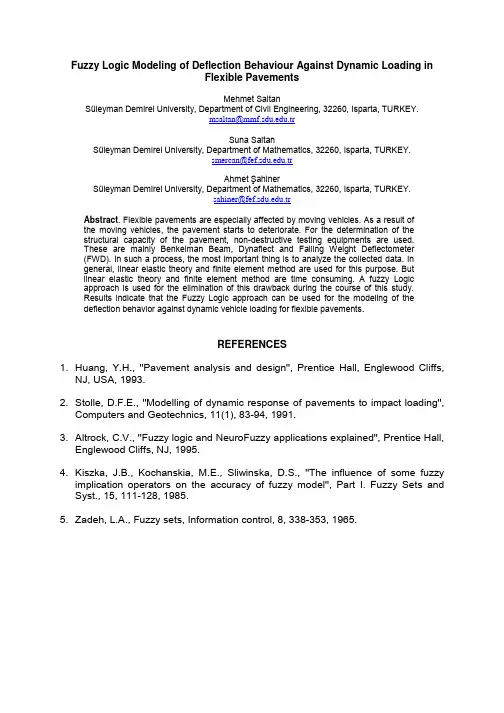
Fuzzy Logic Modeling of Deflection Behaviour Against Dynamic Loading inFlexible PavementsMehmet SaltanSüleyman Demirel University, Department of Civil Engineering, 32260, Isparta, TURKEY.msaltan@.trSuna SaltanSüleyman Demirel University, Department of Mathematics, 32260, Isparta, TURKEY.smercan@.trAhmet ŞahinerSüleyman Demirel University, Department of Mathematics, 32260, Isparta, TURKEY.sahiner@.trAbstract. Flexible pavements are especially affected by moving vehicles. As a result ofthe moving vehicles, the pavement starts to deteriorate. For the determination of thestructural capacity of the pavement, non-destructive testing equipments are used.These are mainly Benkelman Beam, Dynaflect and Falling Weight Deflectometer(FWD). In such a process, the most important thing is to analyze the collected data. Ingeneral, linear elastic theory and finite element method are used for this purpose. Butlinear elastic theory and finite element method are time consuming. A fuzzy Logicapproach is used for the elimination of this drawback during the course of this study.Results indicate that the Fuzzy Logic approach can be used for the modeling of thedeflection behavior against dynamic vehicle loading for flexible pavements.REFERENCES1. Huang, Y.H., ''Pavement analysis and design'', Prentice Hall, Englewood Cliffs,NJ, USA, 1993.2. Stolle, D.F.E., ''Modelling of dynamic response of pavements to impact loading'',Computers and Geotechnics, 11(1), 83-94, 1991.3. Altrock, C.V., ''Fuzzy logic and NeuroFuzzy applications explained'', Prentice Hall,Englewood Cliffs, NJ, 1995.4. Kiszka, J.B., Kochanskia, M.E., Sliwinska, D.S., ''The influence of some fuzzyimplication operators on the accuracy of fuzzy model'', Part I. Fuzzy Sets and Syst., 15, 111-128, 1985.5. Zadeh, L.A., Fuzzy sets, Information control, 8, 338-353, 1965.。
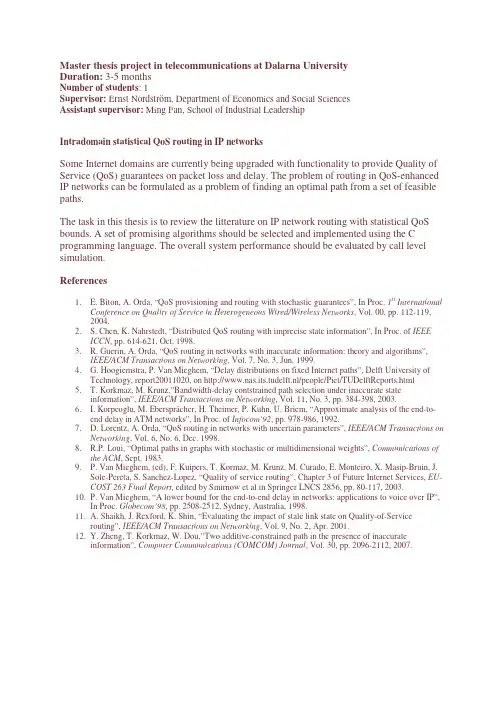
Master thesis project in telecommunications at Dalarna UniversityDuration: 3-5 monthsNumber of students: 1Supervisor: Ernst Nordström, Department of Economics and Social SciencesAssistant supervisor: Ming Fan, School of Industrial LeadershipIntradomain statistical QoS routing in IP networksSome Internet domains are currently being upgraded with functionality to provide Quality of Service (QoS) guarantees on packet loss and delay. The problem of routing in QoS-enhanced IP networks can be formulated as a problem of finding an optimal path from a set of feasible paths.The task in this thesis is to review the litterature on IP network routing with statistical QoS bounds. A set of promising algorithms should be selected and implemented using the C programming language. The overall system performance should be evaluated by call level simulation.References1. E. Biton, A. Orda, “QoS provisioning and routing with stochastic guarantees”, In Proc. 1st InternationalConference on Quality of Service in Heterogeneous Wired/Wireless Networks, Vol. 00, pp. 112-119,2004.2.S. Chen, K. Nahrstedt, “Distributed QoS routing with imprecise state information”, In Proc. of IEEEICCN, pp. 614-621, Oct. 1998.3.R. Guerin, A. Orda, “QoS routing in networks with inaccurate information: theory and algorithms”,IEEE/ACM Transactions on Networking, Vol. 7, No. 3, Jun. 1999.4.G. Hoogiemstra, P. Van Mieghem, “Delay distributions on fixed Internet paths”, Delft University ofTechnology, report20011020, on http://www.nas.its.tudelft.nl/people/Piet/TUDelftReports.html5.T. Korkmaz, M. Krunz,”Bandwidth-delay contstrained path selection under inaccurate stateinformation”, IEEE/ACM Transactions on Networking, Vol. 11, No. 3, pp. 384-398, 2003.6.I. Korpeoglu, M. Ebersprächer, H. Theimer, P. Kuhn, U. Briem, “Approximate analysis of the end-to-end delay in ATM networks”, In Proc. of Infocom’92, pp. 978-986, 1992.7. D. Lorentz, A. Orda, “QoS routing in networks with uncertain parameters”, IEEE/ACM Transactions onNetworking, Vol. 6, No. 6, Dec. 1998.8.R.P. Loui, “Optimal paths in graphs with stochastic or multidimensional weights”, Communications ofthe ACM, Sept. 1983.9.P. Van Mieghem, (ed), F. Kuipers, T. Kormaz, M. Krunz, M. Curado, E. Monteiro, X. Masip-Bruin, J.Sole-Pereta, S. Sanchez-Lopez, “Quality of service routing”, Chapter 3 of Future Internet Services, EU-COST 263 Final Report, edited by Smirnow et al in Springer LNCS 2856, pp. 80-117, 2003.10.P. Van Mieghem, “A lower bound for the end-to-end delay in networks: applications to voice over IP”,In Proc. Globecom’98, pp. 2508-2512, Sydney, Australia, 1998.11. A. Shaikh, J. Rexford, K. Shin, “Evaluating the impact of stale link state on Quality-of-Servicerouting”, IEEE/ACM Transactions on Networking, Vol. 9, No. 2, Apr. 2001.12.Y. Zheng, T. Korkmaz, W. Dou,”Two additive-constrained path in the presence of inaccurateinformation”, Computer Communications (COMCOM) Journal, Vol. 30, pp. 2096-2112, 2007.。
References (in APA style papers)In an APA style paper, the citation sources are listed in References on a separate page, which follows the final page of the text. Entries appear alphabetically according to the last name of the author; two or more works by the same author are listed in chronological order by the date of publication. All entries in the References page must correspond to the sources cited in the main text. The writers are supposed to observe the following rules:(1)All lines after the first line of each entry in the reference list should have one-half-inchhanging indentation from the left margin.(2)Authors’ names are inverted (last name first). If the work has more than seven authors, list thefirst six authors and then use ellipses after the sixt h author’s name. After the ellipses, list the last author’s name of the work.(3)Reference list entries should be alphabetized by the last name of the first author of each work.(4)If you have more than one article by the same author, single-author references ormultiple-author references with the exact same authors in the exact same order are listed in order by the year of publication, starting with the earliest.(5)All major words in journal titles are capitalized.(6)When referring to books, chapters, articles, or Web pages, capitalize only the first letter of thefirst word of a title and subtitle, the first word after a colon or a dash in the title, and proper nouns. Do not capitalize the first letter of the second word in a hyphenated compound word.(7)Italicize titles of longer works such as books and journals.(8)Do not italicize, underline, or put quotes around the titles of shorter works such as journalarticles or essays in edited collections.1. Single-Author BookAitchison, J. (1987). Words in the mind: An introduction to the mental lexicon. Oxford: Basil Blackwell Ltd.Bach, K. (1987). Thought and reference. Oxford: Oxford University Press.2. Book with Two or More AuthorsFodor, J., & Lepore, E. (2002). The compositionality papers. Oxford: Oxford University Press. Hatch, E., & Brown, C. (1995). Vocabulary, semantics, and language education. Cambridge: Cambridge University Press.3. An Edited VolumeCole, P. (Ed). (1981). Radical pragmatics. New York: Academic Press.4. Book without Author or Editor ListedWebster’s new collegiate dictionary. (1961). Springfield, MA: G. & C. Merriam.5. Secondary ResourcesSperber, D. (1994). The modularity of thought and the epistemology of representation. In L. A.Hirschfeld, & S. A. Gelman (Eds.), Mapping the mind: Domain specificity in cognition and culture (pp.39-67). Cambridge: Cambridge University Press.6. JournalsBarsalou, L. W. (1982). Context-independent information and context-dependent information in concepts. Memory & Cognition, 10, 82-93.Hu, Y., Wood, J. F., Smith, V., & Westbrook, N. (2004). Friendships through IM: Examining the relationship between instant messaging and intimacy. Journal of Computer-Mediated Communication, 10(1), 38-48.7. DissertationMarunowski, K. R. (2006). The Euro: a multimodal study in presence. Unpublished doctoral dissertation, Kent State University, Kent, Ohio.8. An Entry in an EncyclopediaBergmann, P. G. (1993). Relativity. In The new encyclopedia britannica (Vol. 26, pp. 501-508).Chicago, IL: Encyclopedia Britannica.9. Conference ProceedingsRichardson, J. F., & Richardson, A. W. (1990). On predicting pragmatic relations. In Proceedings of the 16th Annual Meeting of the Berkeley Linguistic Society, Parasession on the Legacy of Grice (pp. 498-508).Berkeley: Berkeley Linguistic Society.10. Article in a MagazineHenry, W. A., III. (1990, April 9). Making the grade in today’s schools. Time, 135, 28-31.11. Article in a NewspaperSchultz, S. (2005, December 28). Calls made to strengthen state energy policies. The Country Today, pp. 1A, 2A.12. Article From an Online PeriodicalBernstein, M. (2002). 10 tips on writing the living Web. A list apart: For people who make websites, 149. Retrieved from /articles/writelivingSample ReferencesReferencesBergmann, P. G. (1993). Relativity. In The new encyclopedia britannica (Vol. 26, pp. 501-508).Chicago, IL: Encyclopedia Britannica.Bernstein, M. (2002). 10 tips on writing the living Web. A list apart: For people who makewebsites, 149. Retrieved from /articles/writelivingCarston, R.(1998). Informativeness, Relevance and Scalar Implicature. In R. Carston & S. Uchida(Eds.), Relevance theory: applications and implications(pp. 179-236). Amsterdam: JohnBenjamins.Carston, R. (2002). Thoughts and utterances: the pragmatics of explicit communication. Oxford:Blackwell.Castle, G. (2007). New millennial Joyce [Review of the books Twenty-first Joyce, Joyce’s critics:Transitions in reading and culture,and Joyce’s mes sianism: Dante, negative existence, and the messianic self]. Modern Fiction Studies, 50(1), 163-173. Available from Project MUSE Web site: /journals/modern_fiction_studies/toc/mfs52.1.htmlGreen, G. (1989). Pragmatics and natural language understanding. Hillsdale, NJ: Erlbaum. Grice, H. P. (1975). Logic and Conversation. In P. Cole & J. Morgan (Eds.), Syntax & semantics: speech acts (vol.3) (pp. 41-58). New York: Academic Press.Henry, W. A., III. (1990, April 9). Making the grade in toda y’s schools. Time, 135, 28-31. Hirschberg, J. (1985). A theory of scalar implicature. Doctoral dissertation, University of Pennsylvania.Horn, R. (1984). Towards a New Taxonomy for Pragmatic Inference: Q-based and R-based Implicature. In D. Schiffrin (Ed.), Meaning, form, and use in context: linguistic applications (pp. 11-42). Washington, DC: Georgetown University Press.Horn, R. (1989). A nature history of negation. Chicago: University of Chicago Press.Huang, Y. (2004). Neo-Gricean Pragmatic Theory: Looking Back on the Past; Looking Ahead to the Future. Journal of Foreign Languages, 149, 2-25.Huang, Y. (2007). Pragmatics. Cambridge: Cambridge University Press.Jiang, W. Q. (2000). Pragmatics: Theories and applications. Beijing: Beijing University Press. Leech, G. N. (1983). Principles of pragmatics. London: Longman.Levinson S. C.(1991). Pragmatic Reduction of the Binding Conditions Revisited. Journal of Linguistics, 27, 107-61.Levinson, S. C. (1987 a). Minimization and Conversational Inference. In J. Verschueren & M.Bertuccelli-Papi (Eds.),The pragmatic perspective(pp. 61-129). Amsterdam: JohnBenjamins.Levinson, S. C. (1987 b). Pragmatics and the Grammar of Anaphora: a Partial Pragmatic Reduction of Binding and Control Phenomena. Journal of Linguistics, 23, 379-434. Matsui, T. (1993). Bridging reference and the notions of “topic” and “focus”. Lingua, 90, 49 - 68. Matsui, T. (2000). Bridging and relevance. Amsterdam: John Benjamins.Mey, J. L. (1993). Pragmatics. Oxford: Blackwell.Morgan, J. L. (1978). Two types of convention in indirect speech acts. In P. Cole (Ed.), Syntax and semantics, vol. 9 (pp. 261-280). New York: Academic Press.Neale, S. (1992). Paul Grice and the Philosophy of Language. Linguistics and Philosophy, 15, 509-559.Parker-Pope, T. (2008, May 6). Psychiatry handbook linked to drug industry. The New York Times.Retrieved from Recanati, F. (1989). The pragmatics of what is said. Mind and Language, 4, 295-329. Recanati, F. (2002). Does linguistic communication rest on inference? Mind and Language, 17, 105-26.Recanati, F. (2004). Literal meaning. Cambridge: Cambridge University Press.Richardson, J. F., & Richardson, A. W. (1990). On predicting pragmatic relations. In Proceedings of the 16th Annual Meeting of the Berkeley Linguistic Society, Parasession on the Legacy of Grice (pp. 498-508).Berkeley: Berkeley Linguistic Society.Sadock, I. (1986). Remarks on the Paper by Deirdre Wilson and Dan Sperber. Chicago Linguistics Society, 22, 85-90.Schultz, S. (2005, December 28). Calls made to strengthen state energy policies.The CountryToday, pp. 1A, 2A.Sperber, D., & Wilson, D. (1986). Relevance: Communication and cognition. Oxford: Blackwell. Sperber, D., & Wilson, D. (1998). Relevance theory. In L. Horn & G. Ward (Eds.), Handbook of pragmatics. Oxford: Blackwell.Welker, K. (1994). Plans in the common ground: toward a generative account of conversational implicature. Doctoral dissertation, Ohio State University.Yuan, Y. L. (1993). On the valence of nouns in Mandarin. Linguistics, 3, 137-206.。
reference是什么意思
英语单词reference有两层含义:
做名词时,它的意思是说到或写到的事;提到,谈及,涉及;参考,查询,查阅;征求,征询。
其复数形式为:references。
做动词时,它的意思是查阅,参考;给......附参考资料。
扩展资料
第三人称单数:references;现在分词:referencing;过去式:referenced;过去分词:referenced。
一般用法
reference可以与以下词性连用:
1、动词,如:have a reference to 和…有关;make a reference 提及
2、形容词,如:future reference 将来参考;good reference 很好的推荐信
3、介词,如:keep it for reference 备作参考;without reference to 不管,不论,与…无关
向你推荐的相关文章
相关文章列表
微信扫码分享。
Which of the following statement is correct?A. A reference is stored on heap.B. A reference is stored on stack.C. A reference is stored in a queue.D. A reference is stored in a binary tree.2.Which of the following statements is correct?Once a reference variable has been defined to refer to a particular variable it can refer to any other variable.A reference is not a constant pointer.A. Only 1 is correct.B. Only 2 is correct.C. Both 1 and 2 are correct.D. Both 1 and 2 are incorrect.3.Functions can be declared to return a reference type. There are reasons to make such a declaration/Which of the following reasons are correct?The information being returned is a large enough object that returning a reference is more efficient than returning a copy.The type of the function must be a R-value.A. Only 1 is correct.B. Only 2 is correct.C. Both 1 and 2 are correct.D. Both 1 and 2 are incorrect.4.Which of the following statements is correct?Change a reference changes the referent.We can create an array of references.A. Only 1 is correct.B. Only 2 is correct.C. Both 1 and 2 are correct.D. Both 1 and 2 are incorrect.5.Which of the following statement is correct about the references?A. A reference must always be initialized within functions.B. A reference must always be initialized outside all functions.C. A reference must always be initialized.D. Both A and C.A reference is declared using the _____ symbol.A. &&B. &C. ||D. !7.Which of the following statement is correct?A. Once a reference variable has been defined to refer to a particular variable it can refer to any other variable.B. A reference is indicated by using && operator.C. Once a reference variable has been defined to refer to a particular variable it cannot refer to any other variable.D. A reference can be declared beforehand and initialized later.8.Which of the following statements is correct?A reference is not a constant pointer.A referenced is automatically de-referenced.A. Only 1 is correct.B. Only 2 is correct.C. Both 1 and 2 are correct.D. Both 1 and 2 are incorrect.9.Which of the following statements is correct?An array of references is acceptable.We can also create a reference to a reference.A. Only 1 is correct.B. Only 2 is correct.C. Both 1 and 2 are correct.D. Both 1 and 2 are incorrect.10.Which of the following statement is correct?A. A referenced has to be de-referenced to access a value.B. A referenced does not need to be de-referenced to access a value.C. A referenced has to be double de-referenced to access a value.D. Whether a reference should be de-referenced or not depends on the type of the reference.11.Which of the following statements is correct?Once the variable and the reference are linked they are tied together.Once the reference of a variable is declared another reference of that variable is not allowed.A. Only 1 is correct.B. Only 2 is correct.C. Both 1 and 2 are correct.D. Both 1 and 2 are incorrect.Which of the following statements is correct?We can return a global variable by reference.We cannot return a local variable by reference.A. Only 1 is correct.B. Only 2 is correct.C. Both 1 and 2 are correct.D. Both 1 and 2 are incorrect.13.Reference is like a _____.A. PointerB. StructureC. MacroD. Enum14.Which of the following statement is correct?A. A reference is a constant pointer.B. A reference is not a constant pointer.C. An array of references is acceptable.D. It is possible to create a reference to a reference.15.Which of the following statement is correct?A. A reference is declared using * operator.B. Once a reference variable has been defined to refer to a particular variable it can refer to any other variable.C. A reference must always be initialized within classes.D. A variable can have multiple references.16.Which of the following statement is correct?A. An array of references is acceptable.B. Once a reference variable has been defined to refer to a particular variable it can refer to any other variable.C. An array of references is not acceptable.D. Reference is like a structure.17.Which of the following statements is correct?Pointer to a reference and reference to a pointer both are valid.When we use reference, we are actually referring to a referent.A. Only 1 is correct.B. Only 2 is correct.C. Both 1 and 2 are correct.D. Both 1 and 2 are incorrect.。
一.Reference的三种类型: 从书上引用,从杂志里的文章中引用,从网站引用1, 从书上引用的ref,格式:作者名字.年代.书名(斜体).出版社地址: 出版社名Example:Davidson, M. and Cooper, C. (1992). Shattering The Glass Ceiling: The Woman Manger. London: Paul Chapman.2, 从杂志里的文章中引用的ref,格式:作者名字.年代.文章名. 杂志名(斜体): 第几期, 页数Example:Pringle, J. (2004). Women Senior Managers: Successful Individuals Or Markers Of Collective Change. Women’s Studies Journal, 18, (2), 79-963,从网站引用的ref, 格式作者名字.年代.书名(斜体).Retrieved on年月日. from:网站Example:Adler, M. (2005). Women's Employment Concentrated In Service Industries. Retrieved on 20th September, 2005 from:.(注意: 网站另起一行)二, reference 的注意事项:1, 如果reference有两行或两行以上, 从第二行起,向内缩进五到七个字符Example:Rosener, J. (1995). America’s competitive secret: Utilizing women as a management strategy.USA: Oxford University Press.2, reference与reference中间要隔一行3文章名和杂志名:每个单词的首字母大写,虚词除外4,文章后面列出的所有reference必须与加进文章中的reference一一对应5, reference做完以后,以作者的首字为准,按字母顺序进行排列6,一般情况下,1000字,至少四个reference.这里需要强调一点:国外治学严谨,reference一定要做好!!我们的作业严禁直接抄书或从网上直接复制粘贴(这在国外被界定为抄袭)国外的学校有强大的数据库,抄袭的地方,数据库一搜就发现了一旦发现抄袭,轻则挂科,重则拿不到学位,诚信记录还要被写上一笔你可以翻译中文也可以用自己的话把句子转述一遍但是直接引用和一个句子只改2、3个单词是一样会被判抄袭的!To develop a community profile (社区分布)for one Australian Local Government Area (LGA) of your choice, (excluding the City of Boroondara) using data from the 2001 and 2006 Census available from the ABS website. The focus of the demographic profile will be to describe up to three cultural characteristics of the population within your chosen LGA, and look at changes that have occurred from 2001 to 2006.Examples of cultural characteristics are ancestry, birthplace, language spoken, year of arrival in Australia, religious affiliation, English proficiency, and indigenous status. You are expected to synthesise (综合)the information available, not just replicate (折叠,复制)the tables that you can download. For example, you may choose to group a Census table detailing individual birthplaces into categories, and then show the proportional distribution - not just the number by birthplace; or from Year of Arrival in Australia you may derive the number of years living in Australia. In other words, you are required to analyse and summarise the information you find into your own summary tables and charts. In your demographic profile you should include summary tables, charts and commentary to support the graphs and tables. You should make use of data from both the 2001 Census and the 2006 Census (e.g. using a combination QuickStats, MapStats and Census Tables.制定一个社会形象之一澳大利亚地方政府区(儿)您的选择,(不包括城市Boroondara )使用数据从2001年和2006年人口普查可从澳大利亚统计局的网站上。
reference名词解释概述及解释说明1. 引言1.1 概述在撰写学术论文、研究报告、专业文章等过程中,不可避免地需要参考和引用其他已有的文献资料。
为了保证文章的准确性和可信度,提供相关领域的背景知识,并向读者展示作者对文献资源的掌握能力,我们需要使用reference(参考文献)作为支持和证明。
因此,本篇长文将深入解释reference的定义、作用和重要性,并说明其在不同领域的应用。
1.2 文章结构本篇长文将主要分为以下几个部分进行阐述:引言、正文、主要解释说明、实例分析以及结论。
引言部分着重介绍本文的目的和结构概述,让读者对接下来内容有一个清晰的认识。
1.3 目的本篇长文旨在全面而详细地介绍reference并解释其作用和重要性。
通过对reference与引用之间的区别进行阐述,读者将更好地理解如何正确使用reference来支持自己的观点,并规范参考文献的引用方式。
此外,我们还将探讨不同类型reference及其在学术论文中应遵循的标准和规范。
最后,通过实例分析说明reference在实际应用中的价值与意义。
综上所述,本篇长文将帮助读者全面了解reference的定义及其在学术领域的重要作用,并提供正确使用reference以及引用规范的指导,从而提升写作质量和可信度。
一起深入探讨并理解这一有关文献资源的重要主题吧!2. 正文:2.1 定义reference:Reference是一个常见的英语单词,作为名词使用时,它表示对某个实体、事物或概念的引用或提及。
Reference可以是一个书面文献、资源、材料或信息源,也可以是对特定领域中的某个理论、概念或事实的引述。
在学术和研究领域中,reference通常指代与论题相关的参考资料、引文和引用。
2.2 reference的作用和重要性:Reference在各个领域中具有重要作用。
首先,它提供了对已有知识和观点的背景支持,让读者了解特定主题的上下文并深入理解内容。
ReferencesReferences1 Abbott A L, Zhang B, Active Fixation using attentional shifts, affine resampling and multiresolution search, Proc ICCV 1995:1002-10082 Abbott A L, Ahuja N, Surface reconstruction by dynamic integration of focus, camera vergenceand stereo , Proc ICCV 1988:532-5433 Adelson E H , Bergen J R , Spatiotemporal energy model for the perception of motion, J. Opt.Soc. Am.,A2,284-299,19854 Allmen M, Dyer C R, Computing spatiotemporal surface flow, Proc IEEE 3rd ICCV, 1990:p47-505 Allmen M, Dyer C R, Long range spatiotemporal motion understanding using spatiotemporalflow curves, Proc IEEE CVPR 1991: p303-3096 Aloimonos Y, Weiss I, Bandopadhay A, Active vision, Int J CV, vol 2, 1988:333-3567 Aloimonos Y, Purposive and qualitative active vision, Proc. IEEE 10th ICPR1990:346-3608 Aloimonos Y, Rosenfeld A, Computer vision. Science, Vol253. Sept 1991:1181-1324.9 Ariyaeeinia A M, Single camera 3D TV system, SPIE vol 2351 Telemanipulator andTelepresence Technologies,1994:255-23210 A tsumi E ,et al, Internal representation of a neural network that detects local motion , Proc.IJCNN, 1993: 198-20111 A zarbayejani A,Penland A,Recursive estimation of motion, structure, and focal length,IEEE Trans PAMI, Vol. 17, No. 6, Jun. 1995, pp562-575.12 B achelder I A, Waxman A M, Mobile robot visual mapping and localization: a view-basedneural computed architecture that emulates hippocampal place learning, Neural Networks, Vil7 Nos 6/7 1994:1083-109913 B adal S, Ravela S, Draper B, Hanson A, A practical obstacle detection and avoidance system,IEEE Workshop on Applications of Computer Vision, 1994.14 B aillard C and Zisserman A. 1999. Automatic reconstruction of piecewise planar models frommultiple views. In IEEE Conference on Computer Vision and Pattern Recognition, pp. 559-565.15 B ajscy R, Active perception, Proc IEEE, vol 76,1988:996-100516 B aker H H, Bolles R C, Generalizing epipolar-plane image analysis on the spatio-temporoal- 153 -References surface CVPR 1988,pp151017 B aker H H, Bolles R C, Generalization epipolar-plane image analysis on the spatio-temporalsurface, Int. J. CV. 3. 1989:33-4918 B aker S., Szeliski R. and Anandan P, 1998. A layered approach to stereo reconstruction. InCVPR'98: 434-441.19 B allard D H, Behavioral constraints on animate vision, Image and Vision Computing, 7(1)FEB1989:3-920 B allard D H, Barrow C M, Principles of animate vision, CVGIP:IU:56(1) July 1992:3-2121 B ani-Hashemi A, A Fourier approach to camera orientation, In: Proc ICRA, Nice, France, May1992, 1532-153822 B hanu B, Nevatia R, Riseman E M, Dynamic scene and motion analysis using passive sensor,PART I: A qualitative approach, IEEE Expert, vol 7, no 1, Feb 1992: 45-5223 B hanu B, Nevatia R, Riseman E M, Dynamic scene and motion analysis using passive sensor,PART II: Displacement-Field and feature based approaches, IEEE Expert, vol 7, no 1, Feb 1992: 53-6424 B hat D, Nayar S, Stereo in the Presence of Specular Reflection, International Conference onComputer Vision, pp. 1086-1092, June 199525 B lack M J, Jepson A D, Estimating optical flow in segmented images using variable-orderparametric models with local deformations, IEEE Trans PAMI, vol 18, no 10, Oct 1996: 972-986.26 B roida T S, Chellappa R, Estimation object motion parameters from noisy images, IEEE TransPAMI, 8, 1986,:90-9927 B rooks R A, Achieving AI through Building Robots, AI Memo 899, AI Lab, MIT, CambridgeMA, 198628 B rooks R A, Intelligence Without Representation, Artificial Intelligence, Vol. 47, Number 1-3,pp. 139-159, January 199129 B urt P, Wixson L, Salgian G, Electronically directed “focal” stereo, ICCV 95:94-10130 C ipolla R, Yamamoto R, Stereoscopic tracking of bodied in motion, Image and VisionComputing, vol 8, no 1, Feb 1990:85-9031 C ho Y C, Cho H S, A Stereo Vision-based Obstacle Detection method for mobile robotnavigation, Robotica 12,1994:203-216- 154 -References32 C hou G T, A model of figure-ground segregation from kinetic occlusion, Pro ICCV,1995:1050-1057.33 C ollins R, Jaynes C, Cheng Y Q, Wang X G, Stolle F, Schultz S, Hanson A R, Riseman E M,The Umass ascender system for 3D site model construction, In Oscar Firschein and Thomas Strat, editors, RADIUS: Image Understanding for Imagery Intelligence, pages 209-222. Morgan Kaufmann Publishers, 199734 C oombo D, Brown C, Real-time binocular smooth pursuit, Int J Computer Vision, vol 11, no 2,1994: pp147-164.35 C ortelazzo G and Balanza M , Frequency domain analysis of translations with piecewise cubictrajectories, IEEE Trans PAMI, vol 15, No 4, April 1993: p411-41636 C osteira J, Kanade T, A multi-body factorization method for motion analysis, Proc ICCV, 1995:1071-107637 D almia A K, Trivedi M, High speed extraction of 3D structure of selectable quality using atranslating camera, CVIU vol. 64, No 1 , July 1996: 97-11038 D ebevec P, Taylor C and Malik J 1996. Modeling and rendering architecture from photographs:a hybrid geometry- and image- based approach. In ACM Conf. Proc. SIGGRPAH 96, pp. 11-20.39 D ickmanns F D, Graefe V, Dynamic Monocular Machine Vision, Int J MVA, Vol. 1,1988:223-24040 D hond U R, Aggarwal J K, Structure from stereo-A review, IEEE Trans SMC, 19 19891489-151041 E lkins R T, Hall E L, Three dimensional line following using omnidirectional vision, Proc.SPIE vol. 2354 , 1994: pp 130-14442 F augeras O, et al. Realtime correlation-based stereo: algorithm, implementations andapplications. INRIA Technical Report 2013.43 F augeras O, Robert L, Laveau S, Csurka G, Zeller C, Gauclin C and Zoghlami I 1998. 3-Dreconstruction of urban scenes from image sequences. Computer Vision and Image Understanding, 69(3): 292-309.44 F ermiiller C, Aloimonos Y, Vision and action, Image and Vision Computing, Vol. 13, No 10,Dec 1995:725-74445 F reeman W T, Adelson E H, The design and use of steerable filters, IEEE Trans PAMI vol 13,no 9, Sep 1991:891-90646 G oshtasby A, Gruver W A, Design of a single-lens stereo camera system, Pattern Recognotion,- 155 -References vol 26, no 6, 1993:923-937.47 G reguss, P., Panoramic imaging block for three-dimensional space, U.S. Patent 4,566,763 (28Jan, 1986)48 H alfhill T R, See you around, BYTE,May1995:85-90.49 H eeger D J , Optical flow from spatio-temporal filters, In Proc. ICCV, 1987a: p181-19050 H eeger D J, Model for the extraction of image flow, J. Opt. Soc. Am. A, vol 4, no 8, August1987b: 1455-147151 H ong J, Tan X, Pinette B, et al, Image-based homing, Proc Int Conf Robotics and Automation,April 1991, pp 620-625.52 H orn B K P, Robot Vision, The MIT Press, McGrawhill Book Company, 198653 H su S, Anandan P, Peleg S, Accurate computation of optical flow by using layeredrepresentation, Proc ICPR 1994: 743-746.54 I rani M, Rousso B, Peleg S, Computing occluding and transparent motion, Int J CV,12(1),1994:5-1655 I rani M, Ananda P, Hsu S, Mosaic based representation of video sequence and their applications,IEEE Proc ICCV'95, pp605-611.56 I shiguro H, Yamamoto M, Tsuji S, Omni-directional stereo for making global map, Proc.ICCV-90.57 I shiguro H, Development of low-cost compact omnidirectional vision sensors and theirapplications, In Proc. Int. Conf. Information Systems, Analysis and Synthesis, 1998: 433-439.58 J ahne B, Digital Image Processing , Concept, Algorithms and Scientific Applications,Springer-Verlag, 199159 J ochem T, Using virtual active tools to improve autonomous driving tasks, Technical Report,Nov, 1993.60 J ochem T, Pomerleau D, Thorpe C, MANIC: A next generation neurally based autonomous roadfollower, Proc IU Workshop, Washington ,USA, April,199361 J ochem T, Pomerleau D, Thorpe C, Vision guided lane transition, IEEE Sym on IntelligentVehicles, Detroit, USA, Sep 25-26,199562 K ak A C (ed.), Computer Vision and Image Understanding, special issue on . Functionality inObject Recognition, vol. 62, no,2, Sep 1995.63 K anade T, et al, A stereo machine for video-rate dense depth mapping and its new applications.- 156 -References CVPR 1996: pp 196-202.64 K anatani K I, Constraint on length and angle,CVGIP,41 1988:28-4265 K aruppiah D, Zhu Z, Shenoy P, Riseman E M, "A Fault-tolerant distributed vision systemarchitecture for object tracking in a smart room", IEEE Second International Workshop on Computer Vision Systems (with ICCV’01), Vancouver, Canada, July 7-8, 2001.66 K ayaalp A , Eckman J L, Near real-time range detection using a pipeline architecture, IEEETrans SMC, vol. 20, no 6, Nov/Dec 1990.67 K awasaki H, Ikeuchi K, Sakauchi M, Spatio-temporal analysis of Omni Image, Prof. CVPR,2000: 577-58468 K irby M, Sirovich L, Application of the Karhunen-Loeve procedure for the characterization ofhuman faces, IEEE Trans PAMI vol 12, no 1, Jan, 1990.69 K irby M, Weisser F, Dangelmayr G, A model problem in the representation of digital imagesequences, Pattern Recognition, vol 26, no 1, 1993: 63-7370 K onolige, K. Small Vision Systems: Hardware and Implementation. Eighth InternationalSymposium on Robotics Research, Hayama, Japan, October 1997.71 K umar R, Anandan P , Hanna K, Direct recovery of shape from multiple views: a parallax basedapproach. ICPR-94:685-688.72 K urada S, Rankin G W, Sridhar, A trinocular vision system for close-range postion sensing,Optics and Laser Technology, vol 27, no 2 1995:75-79.73 L angley K, Fleet D, Atherton T, Multiple motions from instantaneous frequency, Proc Int ConfCVPR, 1992:846-849.74 L i S , Tsuji S, Selecting distinctive scene features for landmarks, Proc ICRA, 1992:53-5975 L i S , Nagata S, Tsuji S, A navigation system based upon panoramic representation, ProcIEEE/RSJ IROS,1995:p142-7.76 L in. X.Y. , Zhu, Z.G., "Detecting Height From Constrained Motion”, Proc. IEEE 3rdInternational Conference on Computer Vision, Osaka, Japan, 1990: 503-50677 L in X Y, Zhu Z G, Den W., “A Stereo Matching Algorithm Based on Shape Similarity forIndoor Environment Model Building,” Proc. IEEE International Conference Robotics and Automation, 1996;1916-192278 M arr D, Vision: A Computational Investigation into the Human Representation and Processingof Visual Information, Freeman, San Francisco, 1982- 157 -References 中译本:姚国正,刘磊,汪云九译,计算视觉理论,科学出版社,1988。